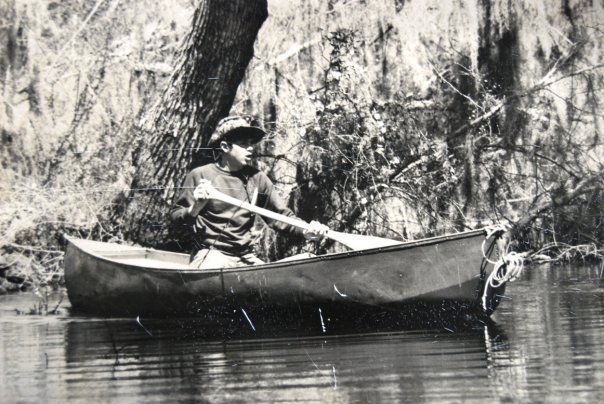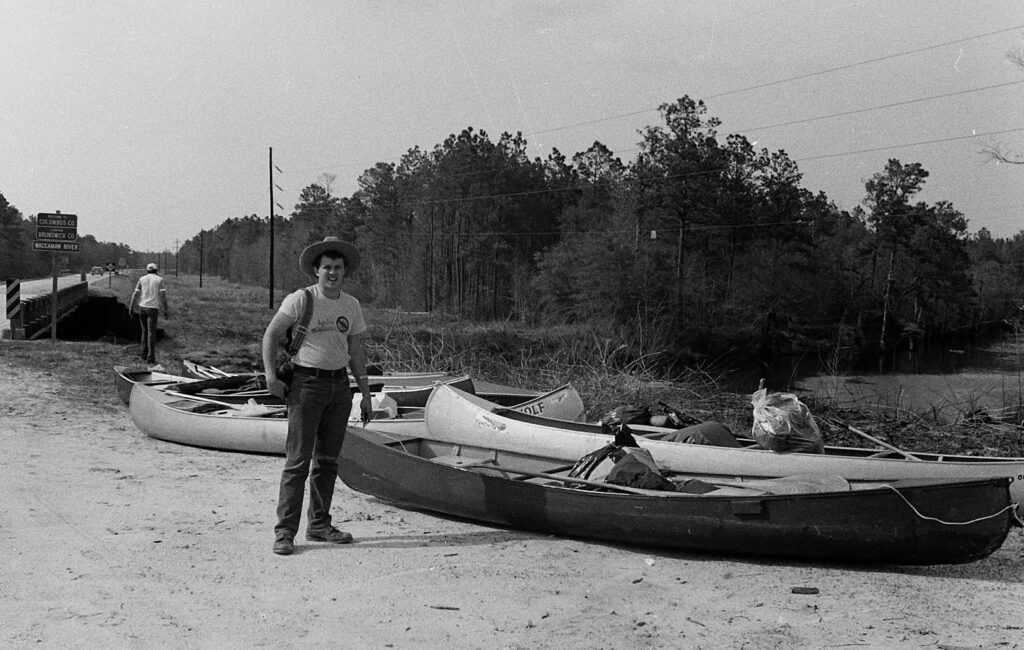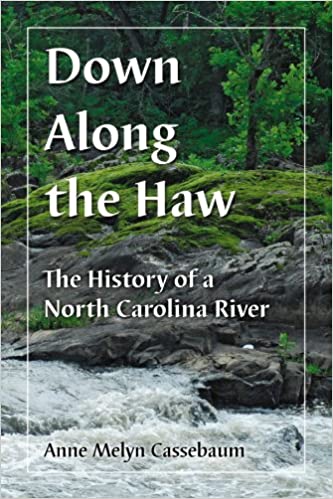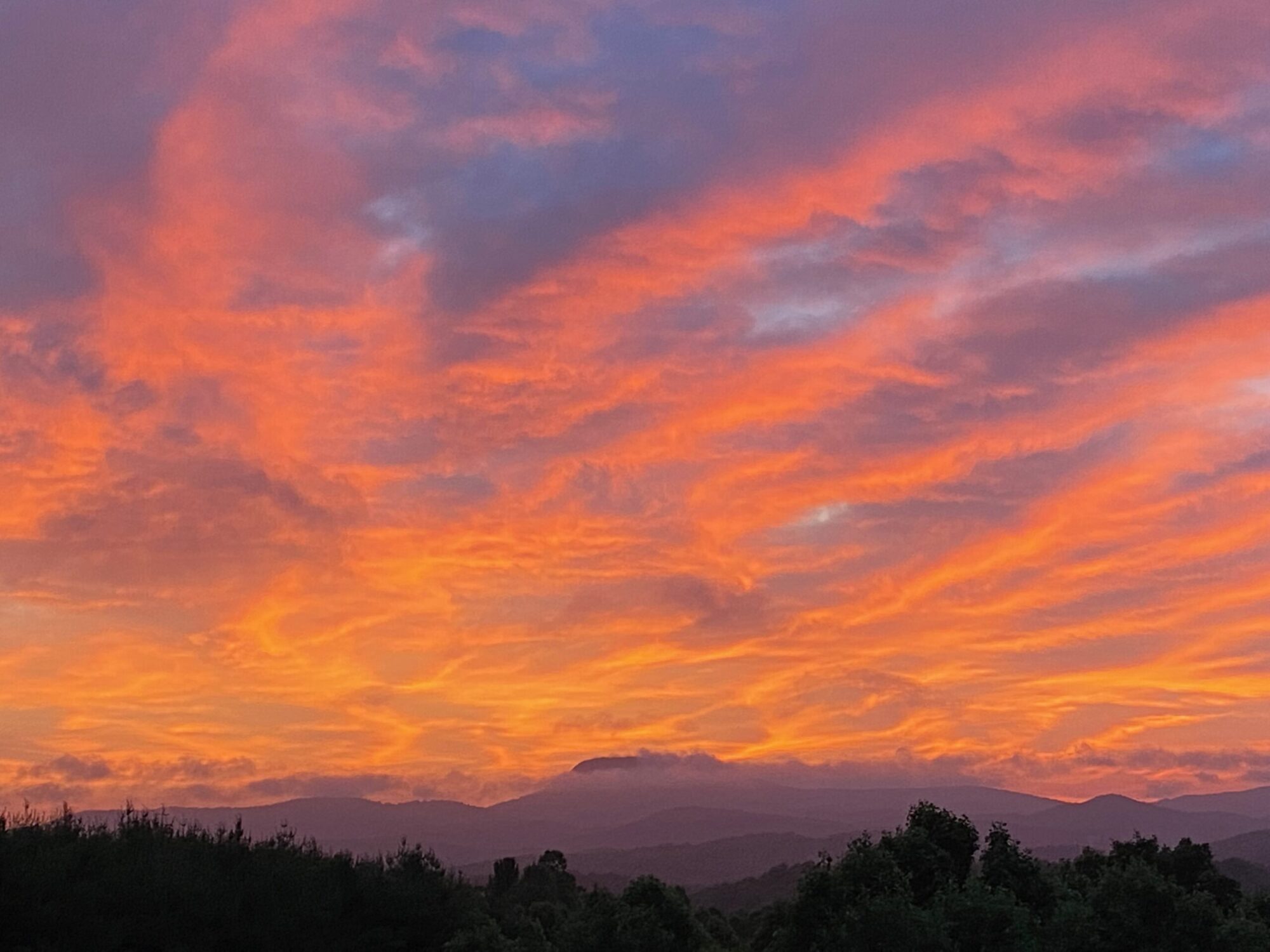Haw River 1975
I pause, standing in the door of the gas station at the edge of Pittsboro, a Coke in one hand and a pack of peanuts in the other. Ripping open the peanuts with my teeth, I shake a few from the bag into my mouth, chasing it with a swig from the bottle as I look out into a gray and dreary February day.
A sheriff deputy pulls up in his cruiser. I watch as he jumps out of his car, fitting his wide brim hat covered with a plastic rain protection on his head. He heads toward our cars, where my Uncle Larry checks the rope tie-downs on his canoe.
Stepping out, the screen door slams shut behind me. Dodging mud puddles in the pavement, I head over toward our vehicles to see that the deputy wants.
“Y’all boys ain’t going to run that river today, are you?” he asks.
We plan on it,” Larry answers.
“That ain’t a good idea. We’ve gotten a lot of rain and that river’s angry.”
“We’ll check the gauge before we put in,” Larry assures him.
“Well, if y’all boys go down that river, I ain’t gonna go lookin’ for you.”
“We’re not asking you to,” Larry responds.
The deputy looks at the canoes on the two cars, then looks back at the two of us. Patting his pistol on his hip, he continues, “I ought to save y’all boys lives and shoot some holes in those canoes.”
I envision him drawing his gun like a deputy from Dodge City, and firing from his hip, ruining my prize possession. Larry wastes no time, responding immediately, “Please sir, don’t do that.”

It’d been raining for days and is still drizzling. My dad and brother leave the store and join Larry and I as the deputy leaves. We discuss his concerns. None of us have paddled this river, but Larry has friends who have been down it. He says that as long as the river is at less than 6 inches on the gauge at the bridge, we should be okay. We drive over, parking along the edge of the highway and walk down under the bridge. The river is muddy and shrouded with fog. The waves of the water rushing pass the bridge abutment to which the gauge is attached are above the three foot mark. We decide to not to run the Haw.
Running the Haw
Two years later, my brother, uncle and I would run the Haw River and would do it many more times, but always in a kayak. It was an exciting in a closed boat when the water was three feet on the gauge. At the first big rapid, Gabriel’s Bend, the river flowed hard into a rock wall and made a ninety degree turn to the left. In high water, one would have to punch through an eight foot standing wave as soon as the left turn was executed, an obstacle that would have swamped and swallowed an open canoe.
What we did that day…
On this day, in 1975, at a time there were few river guides, we looked at a map and decided to run a section of the Rocky River which paralleled the Haw about a dozen miles to the south. We had no idea as to what we’d face, but the river didn’t look nearly as angry as the Haw. We made quick time out of the six or eight mile run. It was evident we could not have made the run at a lower level as there were many rock gardens where the river, even at this height, was only six inches deep.
Toward the end of the run, in sight of the 15-501 bridge, we had to cut across a rapid in order to stay in the main channel. I was in the bow and my dad, who’d never paddled fast water, was in the stern. Suddenly the boat stopped, and water poured in. I looked back at Dad and he was standing in the middle of the river, in knee deep water, holding the boat. He tried to crawl back in, but as he did, I was flipped out. We were both floating through the rapid. I turned around so I was facing down river and pulled my legs up, holding tight to my paddle. It was quite chilly, but at the bottom of the rapid, we were able to beach and dump the water from the boat.
Dad and I paddled the last couple hundred yards in humbled disgrace.

I haven’t found my photos of the Haw, yet. There were never very many in that pre-digital age.
Down Along the Haw

Anne Melyn Cassebaum, Down Along the Haw: The History of a North Carolina River (Jefferson, NC: McFarland, 2011), 229 pages including maps, photos, notes and index.
When I learned there was a book on the Haw River, it went on my to-be-read list. Cassebaum is a professor emerita at Elon University (which I still thought was a college), where she taught environmental and American literature along with writing. In this book, she explores the Haw River from many different viewpoints.
The history of the river
The Haw is an old river that cuts through the rock of a wide fall line. Native Americans fished in the river. Early colonists set up mills along the river and its tributaries. The river plays a role in the ending of the Revolution. Because it was at flood stage during the closing days of the Civil War, it formed a natural boundary between Union and Confederate lines. In the years after the Civil war, the river became home for a large number of textile mills. During this time, the river would take on the hue of the fabric being dyed. It was a polluted mess. After the Clean Water Act of1972, the river slowly cleaned itself. In the 70s, kayakers and canoers began to flock to its waters (see my above piece on my experience on the Haw). Then, in the 80s, with the closing of the B. Everett Jordan dam, named for a US Senator from North Carolina who owned a textile mill along the Haw, the lower part of the Hall was submerged into Jordan Lake.
Other topics explored
In this book, Cassabaum explores the full length of the river, from its headwaters to the confluence with the Deep River to form the Cape Fear. She covers both human and natural history, along with inserting her own stories of paddling and exploring the river. We meet authors who connections to the river’s headwaters including Catholic priest and environmentalist, Thomas Berry, and slave poet, George Moses Horton. Tales of paranormal experiences and haunted islands are shared. We learn of how the river has been “cleaned up” but how threats continue as lawns and agricultural lands pump more and more nutrients into the waters of the Haw. Having last paddled the Haw in the early 1980s, before the floodgates of the B. Everett Jordan dam were closed, I was glad to know that one of my favorite rapids (Gabriel’s Bend) was still available for paddling. Sadly, the Pipeline has long been flooded by the waters of Jordan Lake.
Recommendation
I appreciated the opportunity to learn more about my home state and a river I once knew. For anyone interested in rivers or North Carolina history, check this book out.

Yes, this is an excellent piece, I’m always interested in your book reviews, and this is so you. I too find that especially during any weary times in my life just getting out to nature, the sounds and scents and views lift my spirits almost immediately! Thank you. Take good care of you.
Thank you for sharing your experience! A perfect addiction to a book recommendation and review.
I love stories like that.
“I ought to save y’all boys lives and shoot some holes in those canoes.”
What a line! You could build a movie around a line like that.
This sounds like an interesting book, Jeff. I especially loved reading about your experience leading up to (not) paddling the Haw and then later doing so. Such an exhilarating sport, to ride the rapids. Thanks for sharing the story and book review.
A great write up that reminds many of us of adventures and enjoyment of past ventures on the water. Maybe you will get a chance to enjoy some travel on the James River in Virginia.
A book review with a firsthand account of the subject matter — can’t get better than that.
Powerful writing, Jeff, and the photos bring us into the scene. “Humbled disgrace,” <-I felt it.
Thanks for sharing this. Bravo.
You know, I can only recall my dad paddling in a canoe with me twice after this event. The first time was probably ten years later and the second time almost forty years later. He did, however, take up kayaking (as a way to fish in the creeks that are two narrow and shallow for his boat) when he was around 70!
Sure sounds like this would be a fun thing to do.
It is, but more than that… It’s restorative!
You really bring these adventures to life! It’s been ages since I was in a kayak or canoe. Hope I can introduce the kids to it when they’re a bit older!
I do hope you get your kids onto the water… paddling is one of the best ways to observe the natural world.
A immediate and compelling post, Jeff! I did a little white water rafting in my past. Then a very experienced friend of mine drowned on an angry Colorado River. Now I don’t do that or repel any more. I’m such a chicken! I enjoy your tales vicariously though. Take care!
Water is powerful and even if you’re an excellent swimmer, if you’re in the wrong place. you are in trouble. It is good to respect it.
There’s something about a river that makes me either want to raft it or walk the shore as far as I can go. I’ve also been known to wax poetical after visiting one of them. The metaphors are endless, right?
I’m wondering how the Haw river got its name. Native American? Explorer? Maybe the book has something to say about that.
Yes, rivers are places of solace and peace and inspiration.
As for the name… There is a shrub that grows along the river banks named haw. There was also an early attempt to name the Native Americans along the river, which later became the name of the town “Saxapahaw”. I don’t remember reading where the name came from (in my boxes still packed up is a book on North Carolina place names, but I have to finish the library at home before I open those boxes of books).
What a great story, personal experience, and book. That history sounds fascinating. Not like the Nile–much closer to home. It appeals to me.
You know, I need to read a book about the Nile–I’ve read books about traveling the length of the Amazon, the Mississippi, the Mekong and many other rivers, but not the Nile…
I enjoyed reading the excerpt. The Haw sounds like a wild river. Probably a good thing they didn’t ride it on that day!
That wasn’t an excerpt. It was a piece I wrote from a memory of a time when I was young (and thin and had hair)!
That looks like a very interesting book. Rivers often have interesting histories
Yes, they do, but they are all different. Being along the fall line (where there is a rapid loss in elevation), the rivers were sites of early industrialization. Others were used transportation, irrigation, etc.
Our family (a reunion trip) had a bad canoeing incident when I was about 9 years old, due to heavy rains. I don’t think I’ve ever fully recovered from my fear of water.
That should be a blog post! Maybe you could work through your fears.
The whitewater river I learned on was similar in that once it got high enough it wasn’t recommended to paddle on, not because of big waves or treacherous rapids but because the higher water level often reached down trees that were normally out of the water and turned them into deadly strainers. Older and more experienced, we often went anyway just for the solitude of not having others around but it was more of a float at that point since the rapids were all washed out. I really loved that sweet spot when the water was just high enough to not have to drag your boat anywhere but there were a lot of challenging rock gardens, waves, and powerful eddies to play around in.
This section of the Haw had some neat standing waves during high water. I thought it was all under the lake, but knowing that some rapids survived makes me want to check the river out again. Those strainers can be killers, as I once came close to experiencing when I was swept into a down tree (from some logging right before closing the dam)